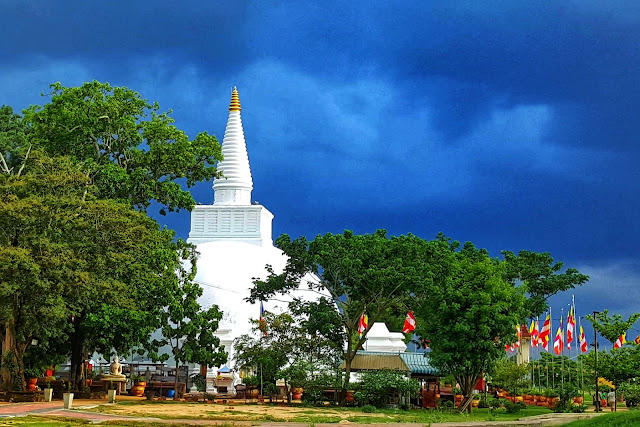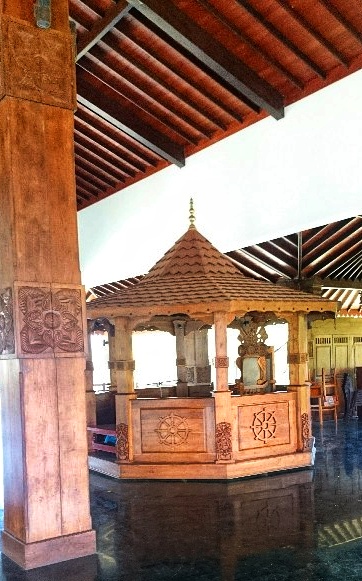Somawathiya Raja Maha Viharaya
Somawathiya
Raja Maha Viharaya is a Buddhist temple located in the Somawathiya
National Park on the left bank of the Mahaweli River in Thamankaduwa Divisional Secretariat Division of Polonnaruwa District of North Central Province, Sri Lanka. In Somawathi Dagoba
is highly revered for enshrining the right tooth relic of Lord Buddha.
Archeological excavations and Historical books such as Palidathuwansaya, Sinhala Dhathuwansaya & Jinakalamaliniya reveal facts about the Somawathi Dagoba. This Dagoba and the land was gazette as an archeological Reserve on July 07, 1967. It no secret about Incredible unnatural phenomena which has been accruing around the stupa. These have been witnessed by thousands of pilgrims.
The story
of Somawathiya Raja Maha Viharaya
Princess Somawathi
(sister of King Kavanthissa who ruled Magampura in Ruhuna) married prince
Abhaya the son-in-low of King Shiva of Kelaniya, and lived in GiriNuwara. Upon the
arrival of King Dutugemunu, Prince Abhaya left GiriNuwara with princess
Somawathi to King Shiva.
After that,
prince Abhaya made a Somapura kingdom near the Mahaweli River in a colony
donated by King Shiva. Prince Abhaya constructed
Somawathi Dagoba on the request of his wife who wanted to engage in religious
activities. And then, Prince Abhaya built a dagoba with a temple in the middle
of a beautiful Sal Forest where 60 Arahants
lived. Upon completion of the dagoba,
the prince and princess requested a Mahinda Thero for giving relics to the dagoba,
then Mahinda Thero donated the right tooth relic of Lord Buddha. After the completion
of the dagoba, the prince named this Viharaya in his princess’s name Somawathi and handed
over the temple to Mahinda maha thero and sixty other monks and also, there are
four temples were built on all four corners and a temple in the inner courtyard
on the north side of the main entrance for the protection of the Somawathi Dagoba.
Current Location
According to the chronicles, the Somawathi Dagoba is located in the Ruhuna area in the east of the Mahaweli River. But over time, now it is connected to the North Central Province about half a mile from the Mahaweli River.
In the 9 BC, King Naga built another dagoba around the old dagoba for the protection of the Tooth Relic and sacrificed the village of Rajapitiya and 28 amunas (Measurements of the area used in ancient Sri Lanka was a system derived from paddy agriculture) from a paddy field called Rajali to the temple and also, two inscriptions were formed.
A 10 rows board the inscription placed near the dagoba, that in 164 AC, King Kanittathissa renovated the Somawathi Dagoba & Temple. In 112 AC, an inscription on the Ericsson (This rock got its name because a photographer called Eric Swan who was killed by a wild elephant near this rock on which the inscription is located) stone states that King Gamini Abhaya (Gajabahu I) donated the income of a village to this temple. Archaeological excavations have revealed that the Somawathiya Raja Maha Viharaya is surrounded by a large wall and the courtyard is 1000 feet east and 600 feet north, south, and west.
 |
| Inscriptions |
 |
| Ruins |
 |
| Carved SriPada |
 |
| Ruins |
In 1987, terrorists went to Somawathi Viharaya and killed about
a Buddhist monk and seven civilians. A few days later, on December 15 of 1987
terrorists returned to the temple, stole the “Chuda
Manikya” (the large gemstone
placed at the very top of the dagoba) and dug about one and a half feet into the
base of the dagoba. since 1966, S. Dissanayake is the caretaker of this land. So,
the terrorists have brutally killed 10 people including his children. On
the same day, the leader of this terror group died at the stupa by mistakenly
firing his own weapon and they left.
Restoration after the terrorist threats
Fifteen years later, the Sri Lanka government
recaptured the temple grounds through a ceasefire agreement between the
terrorists, the gravel roads were reconstructed and open to the pilgrims in 2002. The “Chuda Manikya” was later
discovered by the archeological Department.
 |
| Bo tree |
 |
| Buddha Statue |
 |
| Front Gate |










Comments